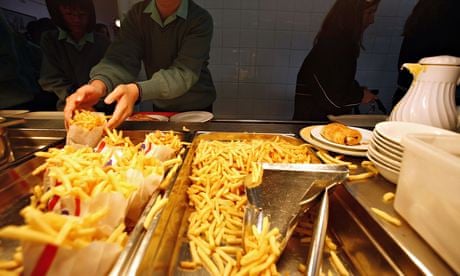In the increasingly high-profile battle against food waste, some of the worst offenders are a group we might hope would know better: schools. The education sector produces 13% of all non-domestic food waste in England, throwing out some 123,000 tonnes a year, the bulk of that going straight to landfill.
Reducing waste is not only good for the environment but it also saves money. According to waste management experts Wrap, food waste costs schools and colleges around £250m a year, and eliminating avoidable waste would cut 22p off an average school meal.
This is quite a challenge when it involves large numbers of children with sometimes unpredictable tastes, but a number of schools are finding innovative and effective ways to reduce the amount of food that ends up in the bin.
David Leake reckons he has cut food waste at Didcot Girls' school by around 75% over two years. Leake, catering manager at the Oxfordshire school, believes the key is to make sure the menu is right. So cabbage is sautéed rather than boiled, all sauces are freshly made, and there is a variety of fresh vegetables on offer.
Monitoring is crucial. Leake keeps a close eye on what sells and what doesn't, to make sure he is serving food the children want – such as cottage pie – and uses the previous week's sales as a guide to how much to order. Leake is also a great believer in quality, so it's topside for steak pies and top quality mince for bolognese and chilli, while vegetables come fresh from local farms. Although it's more expensive, he believes it is better value. "You get more yield out of it," he says. "The cheaper mince cooks down to nothing and becomes very greasy so you end up throwing a lot of it out."
Schools could be tempted to pander to pupils' tastes to reduce waste, even if that meant providing less healthy food, but Leake's experience is that using quality produce and cooking fresh meals makes healthy choices more appealing. "We have chips on Fridays but we stopped selling crisps and cakes and we don't have any complaints," he says.
Another key weapon in the war on waste is the live cook: as much as possible – including omelettes and stir fries – is cooked during lunch, rather than being prepared beforehand.
The result of all this is that waste has reduced dramatically. After feeding 500 people, the kitchens used to discard 8-12kg of food a day; now just 2kg is binned, saving an estimated £2,000 a month.
Getting the food right is fundamental to reducing waste, according to Jeremy Boardman, head of children's catering expertise at the Children's Food Trust. "The key thing is knowing what the customer wants and meeting their requirements," he says.
The introduction of universal free school lunches for infants from September poses an additional challenge for schools if children don't want the food on offer, but there are still ways of keeping waste under control, Boardman argues. Options range from ensuring portion sizes are appropriate for young children to providing a calm environment. "If the dining room is noisy, younger ones can want to get out quickly and they end up leaving their food."
But schools can also find ways outside the kitchen to cut waste. A first step is often raising awareness of the problem. At Loughborough High, the school's eco-committee launched a campaign after realising how much was being thrown out.
They started by measuring a week's waste and then filling the equivalent number of black bags – around 20 – with paper and card and putting them in the middle of the hall so pupils saw them when they arrived for assembly.
"The students found it quite shocking," says Kath Snelling, who chairs the committee and is also head of years 10 and 11. The students were then asked to come up with their own ideas for reducing waste, which included a poster campaign. "That had quite an impact because it was the kids themselves doing it," adds Snelling.
The school has a food committee which regularly discusses the lunch menu, making sure it is what the students want, and prompting a shift to more pasta, baked potatoes and vegetarian choices, as well as a half-portion option. "Since we focused on the waste and tried to provide what the students want there has been a reduction in the amount we throw out," says Snelling.
It's not just lunchtimes where schools can make a difference. St Marie's Roman Catholic primary in Bury encourages children to eat more fruit, which risks wasting any left over at the end of the week. The school came up with "fruity fridays", a project run as part of Keep Britain Tidy's Eco-Schools programme which sees pupils chop up leftover fruit to make fruit cocktails and sell them to classmates.
The Carymoor Environmental Trust in Somerset has worked on waste reduction projects with a number of local primary schools, producing an education pack and organising around 100 trips a year to a landfill site so pupils see what happens to discarded food.
Sue Howes, year 5 teacher and environment co-ordinator at Preston primary in Yeovil, says the visit provided the impetus to run a project on food waste, asking the pupils to think about how much was thrown away.
Pupils – suitably attired and with rubber gloves – also went through the school bins, sorting out how much could be composted, how much could be recycled and how much would go to landfill.
"It has a big impact when they analyse a bin because they quickly realise how much gets thrown away," says Howes.

Comments (…)
Sign in or create your Guardian account to join the discussion